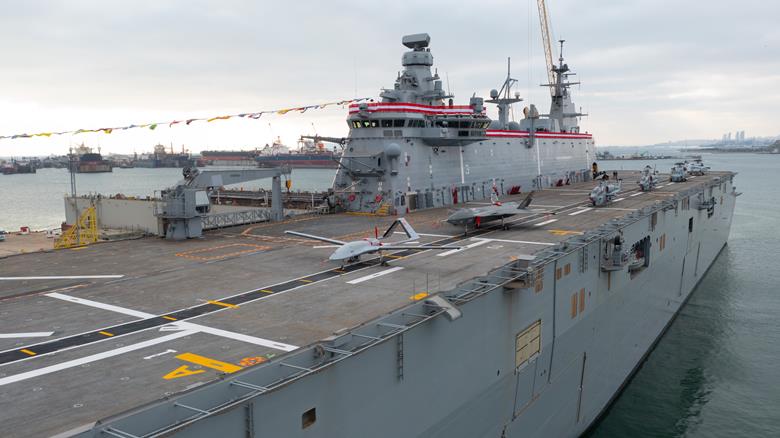Speaking at the commissioning ceremony on 10 April, President Recep Tayyip Erdogan described the new carrier as “the world’s first warship in its field, where the largest and heaviest helicopters and unmanned aerial vehicles can land and take off”.
The US Navy is currently developing its first carrier-launched UAV, the autonomous Boeing MQ-25 Stingray aerial tanker.
The Andalou is a light aircraft carrier, similar to the USA’s America-class amphibious assault ships or the UK Royal Navy’s larger Queen Elizabeth-class carriers. Such vessels are smaller than the US Navy’s Nimitz and Ford-class super carriers, which uses catapults and arresting wires to launch and recover fixed-wing aircraft.
By contrast, the smaller carriers such as the HMS Queen Elizabeth and the Andalou are designed to house specialised short take-off and vertical landing (STOVL) aircraft, including the Lockheed Martin F-35B and Boeing AV-8B Harrier II.
A Nimitz-class carrier is equipped with a 333m (1092ft) flight deck, while the Andalou is 231m in length, according to the online industry publication Turkish Defence Agency.
Turkey had planned to operate the STOVL-capable F-35B variant from its new carrier, with the possibility of Harrier jump jets serving in the interim.
However, that plan was rendered null in 2019, when Washington removed NATO member Turkey from the US-led F-35 development programme. The move was precipitated by Ankara’s purchase of a Russian-made S-400 air defence system.
The two allies have twice held talks on possibility of restoring some of the 100 F-35s Turkey had planned to purchase, although little progress has been made. Ankara has also attempted to purchase Lockheed Martin F-16 fighters, but encountered stiff opposition in the US Congress thus far.
Lacking F-35s, Turkey has instead shifted focus to smaller, domestically produced uncrewed aircraft that can also launch from Andalou. The ship is notable for being the first aircraft carrier to have its air wing primarily built around uncrewed aircraft.
Video from the event shows a number of aircraft on the flight deck of the Andalou, including a Bell AH-1W Super Cobra, Sikorsky S-70B Seahawk utility helicopter and a domestically produced Baykar Bayraktar TB-2 combat UAV.
Baykar’s developmental unmanned fighter jet, the Bayraktar Kizilelma. The single-engined, fixed-wing UAV is expected to make of the bulk of the air wing aboard the Andalou.
The Kizilelma recently made its first flight in December 2022. Baykar calls the type a “fighter UAV” being developed “fully within Turkish borders”. The company describes the Kizilelma has possessing “stealthiest against radar” and “aggressive manoeuvring capability”.
“What’s more, the Bayraktar Kizilelma fighter UAV will be able to take off and land on short-runway aircraft carriers and carry out missions with internally-carried munitions,” Baykar adds.
The company’s websites indicates the unmanned fighter will boast five hours of flight time, a 500nm (926km) flight radius, operational ceiling of 30,000ft and a 1,360kg (3,000lb) payload.
Baykar is also developing a successor to the popular TB-2, which gained fame in the ongoing Russia-Ukraine war for its role in the defence of Kyiv during the conflict’s opening days.
Baykar says the TB-3 will also be capable of launch and recovery from short runway aircraft carriers.
Turkey is also developing an indigenous replacement for its American attack helicopters. The Turkish Aerospace Industries T-929 heavy attack rotorcraft will is planned to eventually replace the Bell Super Cobras on the Andalou flight deck.
By Ryan Finnerty
Source: Flight Global



